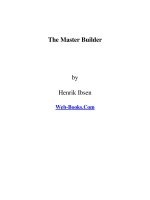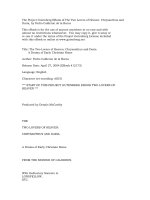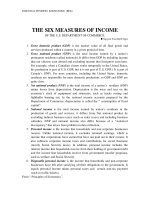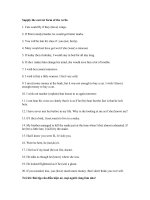The master cheesemakers of wisconsin
Bạn đang xem bản rút gọn của tài liệu. Xem và tải ngay bản đầy đủ của tài liệu tại đây (7.82 MB, 205 trang )
Free ebooks ==> www.Ebook777.com
www.Ebook777.com
Free ebooks ==> www.Ebook777.com
The Master Cheesemakers
o f w i s c on s i n
www.Ebook777.com
publication of this volume
has been made possible, in part, through support from the
Wisconsin Milk Marketing Board, Inc.
and the
dairy farm families of Wisconsin.
!@
QW
The Master Cheesemakers
o f w i s c on s i n
James Norton and Becca Dilley
the university of wisconsin press
Free ebooks ==> www.Ebook777.com
The University of Wisconsin Press
1930 Monroe Street, 3rd Floor
Madison, Wisconsin 53711-2059
uwpress.wisc.edu
3 Henrietta Street
London wce 8lu, England
Copyright © 2009
The Board of Regents of the University of Wisconsin System
All rights reserved. No part of this publication may be reproduced, stored in a retrieval system, or transmitted,
in any format or by any means, digital, electronic, mechanical, photocopying, recording, or otherwise, or conveyed
via the Internet or a Web site without written permission of the University of Wisconsin Press,
except in the case of brief quotations embedded in critical articles and reviews.
5
4
3
2
1
Printed in Canada
Library of Congress Cataloging-in-Publication Data
Norton, James R.
The master cheesemakers of Wisconsin / James Norton and Becca Dilley.
p. cm.
Includes bibliographical references and index.
isbn 978-0-299-23434-8 (pbk. : alk. paper)
1. Cheesemakers—Wisconsin. 2. Cheese—Varieties—Wisconsin.
3. Cheesemaking—Wisconsin. I. Dilley, Becca. II. Title.
sf274.u6.n67 2009
637´.309775—dc22
2009009422
www.Ebook777.com
To all of
Wisconsin’s Master Cheesemakers
whatever their century or decade
-=
contents
!@
preface
acknowledgments
ix
xi
Introduction
3
The Masters of Green County
Bruce Workman
The Buholzer Brothers
Je¤ Wideman and Paul Reigle
Jim Meives
Steve Stettler
Myron Olson and Jamie Fahrney
15
20
25
30
36
39
42
The Masters of Southwestern Wisconsin
Tom Torkelson
Sid Cook
Robert Wills
Doug Peterson
Jake Ni¤enegger
Thomas Jenny
Richard Glick
Gary Grossen
49
54
61
65
69
72
75
78
81
The Masters of Southeastern Wisconsin
Joe Widmer
Kurt Heitmann and Ken DeMaa
85
89
95
Je¤ Mattes
Ken Nett
Kerry Henning
100
103
106
The Masters of Northeastern Wisconsin
Gianni To¤olon
Duane Petersen
Larry Steckbauer
Jim Demeter and Daniel Stearns
Gregg Palubicki
Terry Lensmire
Carie Wagner and Tom Blauert
Roger Krohn
David Metzig
111
115
120
123
126
131
134
137
142
145
The Masters of Northwestern Wisconsin
Scott Erickson
Richard Wold
Randy LaGrander
Bruce Willis and Steven Tollers
John Moran
Vern Kind
David Lindgren
149
153
157
160
164
169
172
175
Other Masters
179
glossary of cheesemaking terms
wisconsin cheese on the web
sources
index
183
185
187
189
Free ebooks ==> www.Ebook777.com
preface
!@
This book was born from more than a mere love of Wisconsin cheese. It also sprang from a deep-seated
conviction that Wisconsin’s master cheesemakers would be incredibly fun guys to get to know. The very phrase
“Wisconsin cheesemaker” is one of those rare, perfect, euphonious expressions that leave you feeling inexplicably
pleased after you hear them.
What’s a Wisconsin cheesemaker like? Without having met any, you might say “jolly,” or “hard-working,” or
“smelling somewhat of cooked milk.” And all of these were true, more or less, of the various folks we met. But
it was a search for other attributes—the subtle, intuitive grasp of math and biology, the Werce dedication to
consistent quality in a profession dominated by Wckle and living ingredients, and a simultaneous dedication to
tradition and progress. It was that search that drove this book.
That search, in turn, led us to spend four months crisscrossing Wisconsin in our Honda Civic to meet—on
his or her home turf—every active master cheesemaker who would meet with us. The fruits of those dozens of
interviews, photo sessions, and cheese tastings are presented to you here, in these pages.
Güten Appetit!
ix
www.Ebook777.com
acknowledgments
!@
The authors would like to thank—Wrst and foremost—the master cheesemakers of Wisconsin. Across the
board, they were happy to meet with us, generous with their time, and gracious to a fault. Getting to meet them
was a reward unto itself. Heather Porter Engwall and Patrick Geoghegan of the Wisconsin Milk Marketing
Board were absolutely instrumental in making this book happen. Cathy Hart of the WMMB was fantastically
patient and helpful under the onslaught of our cheesemaker-related inquiries. We can’t thank WMMB
enough for its Wnancial, moral, logistical, and informational support. Jeanne Carpenter and her blog
(www.cheeseunderground.com) were terriWc resources for us. Thanks, Jeanne—keep blogging! Marianne
Smukowski lined up a four-hour block of interviews with her colleagues at the Center for Dairy Research of
the University of Wisconsin–Madison that was extremely instructive, if exhausting. We’re grateful to her and
all those who took the time to talk with us: Bill Wendor¤, Mark Johnson, John Jaeggi, Dean Sommer, Joanne
Gauthier, and Rusty Bishop. Jim Path gave us an hour-plus interview that put us on the right path in terms of the
master cheesemaker program, and we’re very grateful. John Fox gave us a place to stay in Cedarburg, Wisconsin,
twice, and taught us about string cheese sauce. Josiah and Ingrid Dilley gave us a home-away-from-home for the
seemingly dozens of visits we made to the Madison and Green County area. Cheesemonger/journalist Stephanie
Lucianovic gave us an initial dose of encouragement that put us over the top, and we’re grateful to her, and to
Cowgirl Creamery, the San Francisco cheese shop that planted the initial seed from which this book sprouted.
And we appreciate all that Raphael Kadushin, Sheila Moermond, and Terry Emmrich did to transform this book
from a pile of raw text into the bound volume that you now hold in your hands.
xi
The Master Cheesemakers
o f w i s c on s i n
Introduction
QW
we do not intend for this book to be any sort of deWnitive work on the art and craft of cheesemaking.
The authors were humbled by the knowledge of the cheesemakers, who were humbled by the knowledge of the
sta¤ at the Center for Dairy Research, who were humbled by the complicated and cantankerous living organisms
that are known as “milk” and “cheese.”
Up to a certain point, gaining knowledge about cheese only exposes how little you actually know about it.
Later, that presumably becomes less true, but if any cheesemakers or scientists we spoke to had reached it, they
were too modest or sly to say so.
It is obvious beyond stating that cheese is part of the soul of Wisconsin. It’s easy enough to rattle o¤ economic
statistics that illustrate the signiWcance of the dairy industry, but that misses the essential way that cheese
shaped and deWned the state over the years. Once upon a time, cheese was part of the frontier farmstead life;
European immigrants, looking for a way to make milk last longer and create a tradable commodity, would turn
out small batches. Usually, it was the wife who made the cheese, as the husband worked the Welds. But a steep
decline in wheat production in the 1870s made cheese an attractive economic alternative to grain and shifted the
dairy industry to the forefront. As Jerry Apps notes in Cheese: The Making of a Wisconsin Tradition, the departure
of cheese from the woman’s domain was a welcome shift. Mrs. E. P. Allerton, speaking at the third annual
meeting of the Wisconsin Dairymen’s Association, said, “In many farmhouses, the dairy work loomed up every
year, a mountain that it took all summer to scale. But the mountain is removed; it has been hauled over to the
cheese factory.”
Wisconsin dairy increasingly became a way to prosper, and cheese plants sprang up at almost every rural
crossroads, pooling the milk and other resources of Wve or ten farmers. Milk couldn’t travel far by wagon-hauled
bottle, so plants were everywhere you looked; by 1922, nearly three thousand dotted the state’s countryside. In the
3
4
Introduction
Wrst half of the twentieth century, better roads and the advent of the modern refrigerated bulk milk truck brought
about bigger plants. Little crossroads plants shut down or consolidated, and plants with dozens of workers
became increasingly common.
“There was a plant just about a mile down the road from my mom and dad’s house, which they still live in,”
recalls Lynn Dairy’s David Lindgren. “The plant is gone now—all the little plants have gone by the wayside as
things have grown.”
Time passed, and the national cheese exchange moved from Plymouth, Wisconsin, to Green Bay to the
Chicago Mercantile Exchange. Family farms began to fold, and, with them, small cheese plants began to die or
be consolidated into larger plants by the dozen. Commodity cheese on the large scale became the rule of the day,
but before long states such as California began threatening to outproduce the Wisconsin dairy industry in
terms of sheer volume. A crisis was at hand—the 1980s and early ’90s were hard times, and many in the dairy
industry got out.
The cheesemakers who remained were mostly working at large commodity plants (constantly in danger of
buyout or closure) or small, often struggling old-fashioned plants making traditional Wisconsin cheese. Those
who remained in the business were the tough, the hardy, the resourceful, and, increasingly, the insecure.
“Sometimes you feel like you are one of the last people left,” says David Metzig of the family-owned Union Star
Cheese Factory. “You are the toughest, you survived—but maybe everyone else was smarter and you are the
slowest one. It is a little of both,” he adds with a laugh.
Stabilization came in the late ’90s, as plant closures slowed down, and an increasing recognition of the
unique artisan qualities of Wisconsin cheese began to be seen as a route to salvation for the industry. Wisconsin
cheese, it was realized, was di¤erent. Wisconsin cheesemakers had been around for two, three, even four
generations, making their product in a way that could be traced directly back to European traditions but was
uniquely their own. Many Wisconsin cheesemakers were (and still are) living storehouses of decades of industry
and artisan knowledge, something few other states could boast.
Specialty cheeses have grown from 4 percent of the cheese produced in the state to more than 16 percent in
just a decade, according to a 2008 bulletin from the National Agricultural Statistics Service. Wisconsin now
makes more than 35 percent of all specialty cheese sold in the United States. It also produces more than 600
varieties of cheese to California’s 250, according to a 2007 story in the Fresno Bee.
“I gave a presentation on cheese, and people asked where the cheese came from,” recalls Center for Dairy
Research senior scientist Mark Johnson. “I said, ‘These are all from Wisconsin,’ and people thought I was joking.
They thought they were imported. Every cheese you see imported we can make in Wisconsin. And make just as
good, if not better because we have control over everything. The cheeses you get in Europe are great when they
are made, but then you have to transport them.”
Introduction
5
The Center for Dairy Research
When the Center for Dairy Research was founded at the University of Wisconsin–Madison in 1986, it employed
three people and was a glimmer of its future self. In 2008 the center employed more than thirty people, and now
it exists as a unique crossroads between industry and academia, and theory and practical application.
In its current incarnation, the CDR is like a Jedi High Council of dairy knowledge. When a cheesemaker
takes a problem to the CDR, it’s very likely that one of its people will know the answer. If the CDR can’t answer
a question, it knows scientists who can research it, and—in the process—expand the frontiers of human
knowledge.
The CDR, funded largely by the Wisconsin Milk Marketing Board and private industry, represents a place
where industry can ask questions and Wnd answers. It’s a place where academics can Wnd inspiration for
research, and where research can give back to the state’s economy. It’s a storehouse of knowledge, constantly
refreshed by constant contact with the real world.
Mention the CDR to a cheesemaker, and more often than not, his eyes will light up with respect. “Then we
worked with the CDR” is what you tend to hear when you ask how a new cheese variety was developed, or how a
particularly challenging problem was solved.
“I enjoy working with the people at CDR, and any opportunity I get to work with Mark Johnson or John Jaeggi
or Marianne Smukowski,” says master cheesemaker Roger Krohn. “You just learn so much from those people.”
Despite its high standing in the dairy industry, the CDR maintains a low public proWle.
“The CDR is probably the greatest unknown in the cheese industry today,” says CDR researcher John Jaeggi.
“We like to stay in the background because we strongly believe that the focus should be on those guys—the
cheesemakers, the cheese companies, the ones in the trenches. So most people won’t hear of us, but a lot of the
award winners in cheese contests are a result of work done here.”
The Wisconsin Master Cheesemaker Program
A joint e¤ort sponsored by the Center for Dairy Research and the Wisconsin Milk Marketing Board, the
Wisconsin Master Cheesemaker Program was envisioned as a way to acknowledge the immense depth of
experience and talent that exists within the state’s dairy industry. The CDR would put together courses to top
o¤ the specialized knowledge of the state’s best cheesemakers, and the WMMB would use the Master’s Mark
(a trademark) as a way to market Wisconsin cheese and cheesemakers.
Before even applying to the program, applicants must have held their Wisconsin cheesemaking licenses for at
least ten years. They must pass a strict oral exam from program board members, who are not easily fooled and
Wre questions at a fearsome rate.
6
Introduction
Moreover, they must have been making the cheese variety for which they seek certiWcation for Wve years.
A cheesemaker picks one or two varieties of cheese to master in when entering the program; assuming a
successful completion, he or she might emerge, for example, as a master of cheddar and asiago.
But to pass through and obtain the certiWcate and medal, a would-be master must take more than two years
of courses, consent to constant testing of his cheese and evaluation of his plant, and—after all that—write an
open-book Wnal exam that can run to dozens of handwritten pages of answers.
The whole process runs somewhere between thirteen and Wfteen years, including the initial runup to obtain a
Wisconsin cheesemaker’s license, no small feat unto itself.
Jim Path and the Masters
Originally conceived in the early ’90s, the program was initially propelled and largely shaped by CDR specialty
cheese expert Jim Path, who found inspiration across the Atlantic.
“I started making inquiries about master cheesemaker programs in Europe,” he says. “We identiWed some
programs in Europe—primarily the Swiss program. The Swiss had a good program, the Dutch had a
program. . . . The Swiss deWnitely called theirs master cheesemaker, the Germans had a master cheesemaker . . .
the Italians had a program. So in conjunction with the specialty program I traveled across Europe, and I visited
schools. . . . It was fantastic. It was a dream come true. So we looked at the curriculums, and what became
obvious was that some things Wt and other things didn’t.”
The German program, for example, put students through intensive classroom and in-plant education before
graduating them as master cheesemakers, at the age of twenty-one. Path, who came from a cheesemaking family,
was interested in a program that celebrated and certiWed the time-tested cream of the crop—the veterans.
“We took that program and we looked at experienced cheesemakers; we said, ‘OK, what are the criteria to be a
master cheesemaker?’” he says. “You need a Wisconsin license. You need x number of years as an experienced,
licensed cheesemaker. Then you need to go through some type of vocational courses and complete those courses
and have some testing along the way.”
In addition, the program’s board evaluates the health and sanitation aspects of would-be masters’ plants,
and tests their cheese. Just constituting the board was a challenge—Path said there was a struggle to make it
balanced.
“We tried to get a balance of big factories and small factories,” he says.
The program was designed to further two goals.
“One was education, and that was our bailiwick at the Center for Dairy Research,” Path says. “And the other
was promotion, and that was WMMB. So basically, they took care of the promotion of the Wisconsin Master
Free ebooks ==> www.Ebook777.com
Introduction
7
Cheesemaker Program to promote Wisconsin cheeses, and we were involved in the educational aspect . . . and
that was dear to my heart, and dear to the hearts of the cheesemakers who were involved.”
Emeritus professor Bill Wendor¤ and senior scientist Mark Johnson of the CDR were also instrumental
in making the program challenging for even the most experienced of cheesemakers, Path says. Path, for
his part, put an emphasis on bringing European instructors to Wisconsin to teach old cheesemakers
new tricks.
“We had just outstanding instructors come over,” he says. “We’d spotlight cheeses from this or that particular
country, and they’d do three or four cheeses. We’d have other microbiological seminars, process cheese
seminars, so we built up a curriculum from nothing.
“In our Wrst graduating classes we had large and we had small cheesemakers, and it had a lot of credibility,”
Path says. “I think the thing that really touched my heart a lot was they were on the young side. Now we see
generational, where’s there’s been a master whose son is coming into the program. When you see generational,
you say, ‘Wow, that’s really something.’”
Wendor¤ adds, “It’s kind of like being a country doctor who delivers babies and watches them grow up and go
through high school. You take a look at some of these guys and you see what they’ve done and you just feel good
about how what you’re doing in the program is really contributing toward that.”
Walking through a Cheese Plant
Visitors and workers must suit up before walking the Xoor of a cheese plant. Hair nets and white coats (cloth or
disposable) are required. In big plants, disposable earplugs are a must, often in tandem with safety glasses and
slip-on paper booties for the feet.
Wherever you look there is a hose, sometimes underfoot, sometimes gushing into a vat or bucket or drain,
sometimes coiled up, out of use, resting like a dormant snake. Cheese plants are places of humidity; it drips
down glass, oozes across the Xoor, drains from vats, escapes from blocks of cheese placed in vacuum chambers;
it is the key to certain aspects of cheesemaking, the bane of others. Antiseptic foam hisses quietly from nozzles
near doorways, and the squishy tramp of shoes marching through a half-inch of surging white foam becomes
one of the sounds a frequent cheese plant visitor learns to recognize.
At big plants, visitors are dwarfed by the scale. Holding or maturation tanks that hold tens of thousands of
pounds of milk are not unusual. Closed vats can easily contain an automobile and, in some cases, a driveway to
park it in. At small plants, visitors are impressed by the accessibility of the cheese; in embryonic form, it’s close
at hand, touchably close, curds and whey Wlling open vats. It sits in forms; it Wlls small cooling and aging and
storage rooms, tantalizingly colorful and portable.
www.Ebook777.com
8
Introduction
Stainless steel and white plastic predominate. If you go to a small artisan plant, there are curd knives and
screens for cutting the curd to release additional whey, and forms that are Wlled by hand. Bigger plants have
computer screens and, occasionally, robot arms that could easily crush a toolshed, but are employed, instead, to
cut curd or move 640-pound blocks of cheese to where its masters would like it to be.
What Cheesemakers Are Like
Some cheesemakers are lean and wiry, most have big hands and broad shoulders, and some have a gut but
are powerfully built nonetheless. In big factories, they are responsible for complicated “make” schedules,
Touring Wisconsin Cheese Plants
Many of Wisconsin’s master cheesemakers preside over large factory operations where tours aren’t particularly practical.
Fortunately, quite a few of the smaller and midsized operations allow and welcome visitors who might be curious about the
state’s dairy heritage.
If you’re determined to see cheese being made, it’s always best to call ahead. Some plants take a day or two o¤ each week for
maintenance, and cheese is often made only during speciWc hours of the day—typically before eleven in the morning.
Near Milwaukee / Fox Valley
Watching the team at Widmer’s Cheese Cellars (Theresa) mat and mill their cheddar curd—or crank out old-fashioned brick—is a
real Wisconsin treat. Joe Widmer is a consummate cheese showman, and his tiny shop doesn’t overlook the action so much as it
is surrounded by it. www.widmerscheese.com/ ph. (888) 878-1107
At Henning’s Wisconsin Cheese (Kiel) visitors can view the plant through a picture window and tour a charming little cheese
antiques museum. There’s also a bustling retail operation that boasts some unique opportunities to sample master cheesemaker
Kerry Henning’s latest experiments. www.henningscheese.com/ ph. (920) 894-3032
In or Near Madison
Although the cheesemaking process isn’t immediately on display at Cedar Grove Cheese (Plain), Robert Wills o¤ers frequent tours
and is happy to show o¤ the plant’s Living Machine. www.cedargrovecheese.com/ ph. (800) 200-6020
The Babcock Hall Dairy Plant is made for teaching, so it’s quite accessible to the public. Self-guided tours can be arranged,
and the Babcock Hall Dairy Store sells the plant’s legendary ice cream and a variety of cheeses.
www.foodsci.wisc.edu/services/dairy/ ph. (608) 263-2008
Introduction
9
human resource decisions, the cost of milk and other ingredients, and the constant requests and complaints of
customers. In small plants, they do all this plus electrical work, plumbing, carpentry, marketing, and more.
If you are looking for the antithesis of the modern, depressed, American oªce cubicle dweller, slumped over
a PC loaded with a set of spreadsheets and Minesweeper, look no further than the master cheesemaker. Before
eight in the morning, most have done more than an oªce worker does in a week.
Cheesemakers appear eerily young. A polite rule of thumb says that when you’re guessing the age of a lady,
deduct seven from your actual estimate; with cheesemakers, if you hope to actually guess the right age, you
should probably add ten or Wfteen years. I have met sixty-year-old cheesemakers who could twist me up into a
pretzel and throw me into a well if it became absolutely necessary. And a lifetime of juggling variables and
Near Wisconsin Dells
Carr Valley Cheese Company has become rightfully famous for its selection of American Original cheeses that are unique to its
plant. A small window o¤ers a view of the plant. www.carrvalleycheese.com/ ph. (800) 462-7258
Near Wausau
The sprawling retail operation of Wisconsin Dairy State Cheese Company (Rudolph) boasts a big viewing window, tables and
chairs, and an ice-cream shop. ph. (715) 435-3144
Near Minneapolis–St. Paul
Bass Lake Cheese Factory (Somerset) o¤ers periodic wine and cheese tastings, an observation window, and an engaging, informal
cheese heritage museum. Its store also boasts a selection of unique sheep and goat milk cheeses. www.blcheese.com/
ph. (715) 247-5586
Near Green Bay
At Union Star Cheese Factory (Zittau), David Metzig makes cheese the old-fashioned way, and sells some of the tastiest cheddar
and string cheese in the state. www.unionstarcheese.com/ ph. (800) 354-3373
10
Introduction
multitasking keeps the minds of cheesemakers sharp. Try spending a day worrying about acid levels, developing
a new kind of aged cheddar laced with fruit, the amount of cheese in the warehouse, that recurring temperature
problem with the pasteurizer (and the new guy who seems to be slacking o¤ instead of working, of course), and
see if you don’t feel a little more mentally agile when you’re through.
“They’re all over the board, personally,” says Jim Path. “One thing that they probably have in common is
that they’re extremely independent. Their personalities are all over the board, they vary from colorful”—here he
chuckles—“to pretty methodical. They share a love of cheesemaking.”
It seems sappy to observe that cheesemakers are good people, but it’s impossible to avoid that conclusion.
“They’re the kind of guys who, if you were on a sinking ship, would start tearing o¤ doors and putting people
on them,” says Carie Wagner of Foremost Farms USA. “And then handing you a beer as you Xoat o¤. ‘You need
a beverage!’”
They are accustomed to hard work, bred to share credit and shy away from the limelight, prone to handling
problems by grabbing them head-on and wrestling them to the ground. There is very little glamour and only
modest riches to be gained from making cheese twelve hours a day, Wve, six, or even seven days a week. Those
who put up with the absurd hours, the heavy lifting, the economic pressure, and the smell of milk on their
clothes and hair are the kind of people who think nothing of going a little bit out of their way to help another
person deal with a problem.
The Cheesemaker’s Life
The day-to-day life for a cheesemaker varies wildly. Some are preoccupied with smearing bacteria wash on aging
wheels, and matting out cheddar curds. Others are using world-class science to troubleshoot minute aspects of a
given cheese’s performance in order to satisfy the demands of a customer who places orders by the millions of
pounds. Most think about sales, marketing, human resources, sanitation, product development, labels, and
equipment.
What master cheesemakers have in common, regardless of the size of their plants, is a soup-to-nuts
understanding of their product, from the silage or grass eaten by the cows to the Wnished, often aged cheese
eaten by consumers. The art of cheesemaking is less obvious when it’s concealed by enormous closed vats and
640-pound-capacity wooden crates, but it’s there. The challenge of making a consistent, delicious end product
is a constant struggle regardless of the size of the operation in question.
Some masters are tinkerers, constantly changing recipes and playing with the milk, culture, and rennet in
search of some wonderful undiscovered or long-forgotten cheese. Some are overseers of vast quantity, judging
success on the movement of tractor-trailers of perfectly consistent cheese. But all of them are workhorses.
Introduction
11
Making cheese is not for the lazy, or even the conventionally hard working. Twenty-four-hour plant cycles,
o¤-peak electricity, milk delivery schedules, and a whole host of other reasons mean that many masters start
their days at four in the morning, or three, or even two.
And if you’re not juggling one of the dozens of fussy variables that go into making good cheese, you’re
probably working at one of the other jobs that are part of your “cheesemaker” title—engineer, CEO, foreman,
janitor, cheerleader, accountant, or tour guide.
Only experience in multitasking, gained over time, can make a true master.
“Cheesemaking is like driving a car. When you Wrst start, there is so much to watch—all the gauges, the
temperature, what is this,” says Dean Sommer, a CDR technologist. “You know the rules, and you can get down
How to Make Cheese, Briefly
Trying to describe how cheese is made is like trying to describe how a bakery makes everything that it sells. A cupcake, a
croissant, a loaf of bread, and a chocolate chip cookie are all similar in many ways, but the make procedure varies considerably
from one item to the next. If anything, cheese is even more variable—it’s diªcult to generalize beyond a few commonly
practiced steps.
Cheese begins with milk. After that, things get complicated. In general, the milk is pasteurized and cooled—although there are
raw milk cheeses, which are illegal for sale in the United States unless they’ve been aged for sixty days. Starter bacteria and rennet
enzymes are then—generally—added to the pasteurized milk. The rennet separates the curd (which will become cheese) from the
whey, which is siphoned o¤ and either discarded or processed into a variety of dairy protein–related products. Whey can also be
made into specialized cheeses, such as ricotta or gjetost.
The starter bacteria are allowed to work on the cheese-in-progress, changing its acidity and Xavor proWle. The bacteria’s
progress is carefully regulated by the cheesemaker, who uses a combination of salt, temperature, and curd cutting to control how
rapidly the cheese evolves.
The curd can now be stacked and milled (cheddar), heated and pressed Wrmly (parmesan, asiago, emmental), injected and/or
washed with ripening microbes over a course of hours or days (limburger, camembert, blue), pickled in brine (feta), heated and
stretched (mozzarella, provolone), or washed in warm water and pressed (edam, gouda).
A variety of aging (aªnage) techniques that can be applied to cheese include washing the cheese with beer or wine, rotating
and/or Xipping the cheese, or adjusting temperature and humidity levels in the aging room. The degree to which a cheese ages
varies radically by variety. Some cheeses are best consumed almost immediately, or in the Wrst few weeks of life, such as fresh
mozzarella or mascarpone. Others, such as parmesan, provolone, or cheddar, are made to be aged and often reach a peak two,
three, Wve, or even ten years after they’re made. Cheesemakers tell tales of twenty- or even twenty-eight-year-old cheddars that are
still edible, if not actually delicious.
12
Introduction
the road, but you don’t have the feel and the comfort level. That is the artistry, the comfort level. With
cheesemaking, you don’t have to watch the pH meter constantly; you can look and see and feel and know how
it is going.”
Mass-Produced versus Artisanal Cheese
While many master cheesemakers are full-Xedged artisanal makers or utilize some artisanal methods of
production, the line that separates large-scale commercial operations from small artisanal shops is far blurrier
than it may initially look. It’s impossible to say what precisely indicates an artisanal maker, but here are a few
likely possibilities:
An emphasis on quality over consistency
Personal handling of the cheese (cutting the curd by hand, turning aging cheese by hand, Wlling forms
by hand)
Small volume production (a few thousand pounds a day)
Experimentation and the production of many di¤erent sorts of cheese, some seasonal, some one-o¤s
The use of specialty milks (goat, sheep, pasture-grazed cow, certiWed organic)
Sale to gourmet cheese shops, direct to public, high-end restaurants
Using more (usually more specially trained) employees per pound of cheese produced.
By contrast, you could expect a plant emphasizing mass production to:
Use only standard cow milk
Produce only a few kinds of cheese
Produce many thousands of pounds of cheese daily
Rely on machines to stir curd and move cheese throughout the production cycle
Sell large volumes of cheese for industrial food service or large grocery chain needs
Emphasize a consistent product produced on an unvarying schedule
Use fewer (usually more generally trained) employees per pound of cheese produced.
Few master cheesemakers fall squarely into either category, however. There are plants making small amounts
of specialty cheese that use some automated equipment and no particularly special kinds of milk; there are
huge plants concerned with making high-priced gourmet cheese or constantly experimenting with many new
products. Most master cheesemakers have operations that fall somewhere along the spectrum between classic
artisanal maker and full-Xedged mass producer, without being completely on either end.









